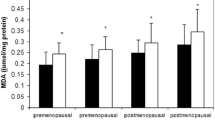Abstract
Purpose
To investigate oxidant/antioxidant status in premenstrual syndrome (PMS).
Methods
Study group (n = 20) consisted of PMS and control group (n = 21) consisted of normal menstruating women. The serum oxidant status was assessed by the lipid hydroperoxide (LHP), malondialdehyde (MDA) and protein carbonyl (PC); the antioxidant status was assessed by the total thiol (T-SH) and total antioxidant capacity (TAC).
Results
The study and control groups revealed no statistical difference, in terms of day 3 LHP, MDA, PC, T-SH and TAC levels. There were no significant differences between groups in terms of day 21 MDA, PC and T-SH levels. However, day 21 LHP levels were increased and TAC levels were decreased in the study group compared with the control group.
Conclusion
Increased oxidative stress and reduced antioxidant capacity may occur in PMS. It can be speculated that the imbalance of oxidant/antioxidant systems may be a cause or the consequence of the various stress symptoms in PMS.
Similar content being viewed by others
References
Freeman EW (2003) Premenstrual syndrome and premenstrual dysphoric disorder: definitions and diagnosis. Psychoneuroendocrinology 28:25–37
Halbreich U (2004) The diagnosis of premenstrual syndromes and premenstrual dysphoric disorder-clinical procedures and research perspectives. Gynecol Endocrinol 19:320–334
Steiner M, Pearlstein T, Cohen LS, Endicott J, Kornstein SG, Roberts C et al (2006) Expert guidelines for the treatment of severe PMS, PMDD, and comorbidities: the role of SSRIs. J Womens Health 15:57–69
Halbreich U, Borenstein J, Pearlstein T, Kahn LS (2003) The prevalence, impairment, impact, and burden of premenstrual dysphoric disorder (PMS/PMDD). Psychoneuroendocrinology 28:1–23
Alpay FB, Turhan NO (2001) Intermittent versus continuous sertraline therapy in the treatment of premenstrual dysphoric disorders. Int J Fertil Womens Med 46:228–231
Halbreich U (2003) The etiology, biology, and evolving pathology of premenstrual syndromes. Psychoneuroendocrinology 28:55–99
Kendler KS, Karkowski LM, Corey LA, Neale MC (1998) Longitudinal population-based twin study of retrospectively reported premenstrual symptoms and lifetime major depression. Am J Psychiatry 155:1234–1240
Reame NE, Marshall JC, Kelch RP (1992) Pulsatile LH secretion in women with premenstrual syndrome (PMS): evidence for normal neuroregulation of the menstrual cycle. Psychoneuroendocrinology 17:205–213
Bäckström T, Andersson A, Andreé L, Birzniece V, Bixo M, Björn I et al (2003) Pathogenesis in menstrual cycle-linked CNS disorders. Ann N Y Acad Sci 1007:42–53
Evans MD, Dizdaroglu M, Cooke MS (2004) Oxidative DNA damage and disease: induction, repair and significance. Mutat Res 567:1–61
Madamanchi NR, Vendrov A, Runge MS (2005) Oxidative stress and vascular disease. Arterioscler Thromb Vasc Biol 25:29–38
Khanzode SD, Dakhale GN, Khanzode SS, Saoji A, Palasodkar R (2003) Oxidative damage and major depression: the potential antioxidant action of selective serotonin re-uptake inhibitors. Redox Rep 8:365–370
Arranz L, Guayerbas N, De la Fuente M (2007) Impairment of several immune functions in anxious women. J Psychosom Res 62:1–8
Harma M, Harma M, Erel O (2005) Measurement of the total antioxidant response in preeclampsia with a novel automated method. Eur J Obstet Gynecol Reprod Biol 118:47–51
Harma M, Harma M, Kocyigit A (2004) Comparison of protein carbonyl and total plasma thiol concentrations in patients with complete hydatidiform mole with those in healthy pregnant women. Acta Obstet Gynecol Scand 83:857–860
Lagod L, Paszkowski T, Sikorski R, Rola R (2001) The antioxidant prooxidant balance in pregnancy complicated by spontaneous abortion. Ginekol Pol 72:1073–1078
Freemen E, Rickels K, Sondheimer SJ, Polansky M (1990) Ineffectiveness of progesteron suppository treatment for premenstrual syndrome. JAMA 264:349–353
Zadeh-Nourooz J, Tajaddini-Sarmadi J, Wolff S (1994) Measurement of plasma hydroperoxide concentrations by the ferrous oxidation-xylenol orange assay in conjunction with triphenylphosphine. Anal Biochem 220:403–409
Ohkawa H, Ohishi N, Yagi K (1979) Assay for lipid peroxides in animal tissues by thiobarbituric acid reaction. Anal Biochem 95:351–358
Sedlak J, Lindsay RH (1968) Estimation of total, protein-bound, and nonprotein sulfhydryl groups in tissue with Ellman’s reagent. Anal Biochem 25:192–205
Benzie IF, Strain JJ (1999) Ferric reducing/antioxidant power assay: direct measure of total antioxidant activity of biological fluids and modified version for simultaneous measurement of total antioxidant power and ascorbic acid concentration. Method Enzymol 299:15–27
Korzekwa MI, Steiner M (1997) Premenstrual syndromes. Clin Obstet Gynecol 40:564–576
Kalia G, Sudheendran S, Rao A (2001) Antioxidant status and lipid peroxidation in premenstrual syndrome: a preliminary study. Clin Chim Acta 309:97–99
Balat O, Dikensoy E, Ugur MG, Atmaca R, Cekmen M, Yurekli M (2007) Malon dialdehyde, nitrite and adrenomedullin levels in patients with premenstrual syndrome. Arch Gynecol Obstet 275:361–365
Bäckström T, Sanders D, Leask R, Davidson D, Warner P, Bancroft J (1983) Mood, sexuality, hormones, and the menstrual cycle II: hormone levels and their relationship to the premenstrual syndrome. Psychosom Med 45:503–507
Halbreich U, Endicott J, Goldstein S, Nee J (1986) Premenstrual changes and changes in gonadal hormones. Acta Psychiatr Scand 74:576–586
Bremner JD, Innis RB, White T, Fujita M, Silbersweig D, Goddard AW et al (2000) SPECT [I-123] iomazenil measurement of the benzodiazepine receptor in panic disorder. Biol Psychiatry 47:96–106
Smith MJ, Adams LF, Schmidt PJ, Rubinow DR, Wassermann EM (2003) Abnormal luteal phase excitability of the motor cortex in women with premenstrual syndrome. Biol Psychiatry 54:757–762
Rammal H, Bouayed J, Younos C, Soulimani R (2008) Evidence that oxidative stress is linked to anxiety-related behaviour in mice. Brain Behav Immun 22:1156–1159
Conflict of interest statement
I certify that no actual or potential conflict of interest in relation to this article exists.
Author information
Authors and Affiliations
Corresponding author
Rights and permissions
About this article
Cite this article
Duvan, C.I., Cumaoglu, A., Turhan, N.O. et al. Oxidant/antioxidant status in premenstrual syndrome. Arch Gynecol Obstet 283, 299–304 (2011). https://doi.org/10.1007/s00404-009-1347-y
Received:
Accepted:
Published:
Issue Date:
DOI: https://doi.org/10.1007/s00404-009-1347-y




